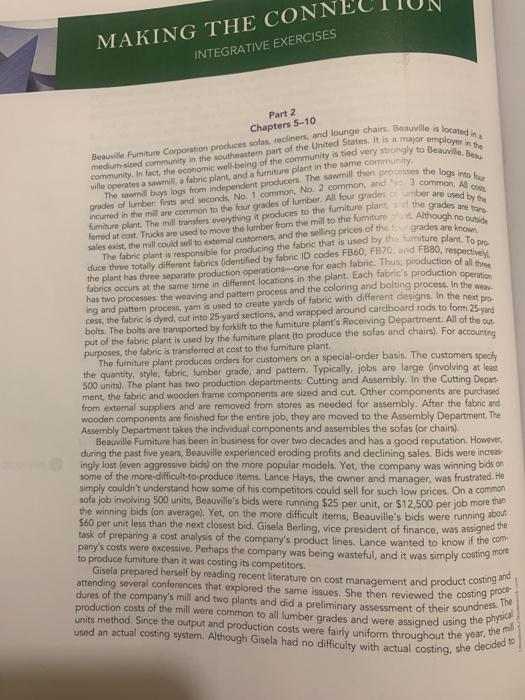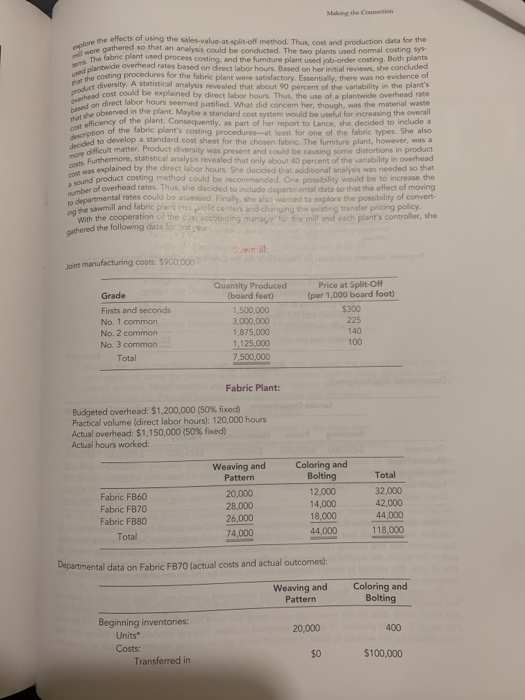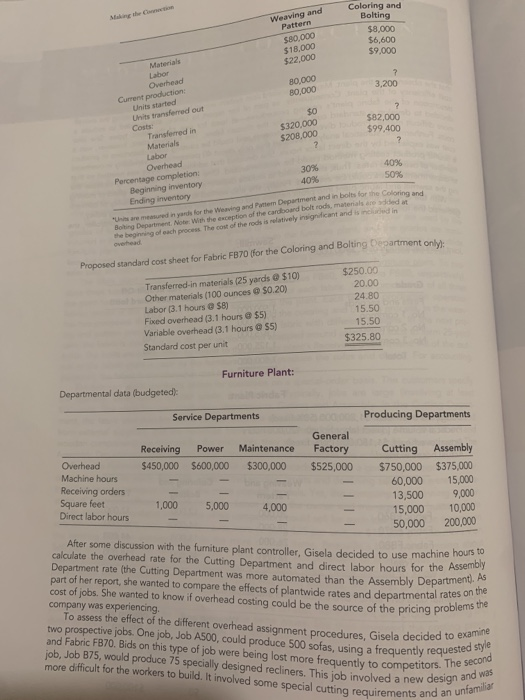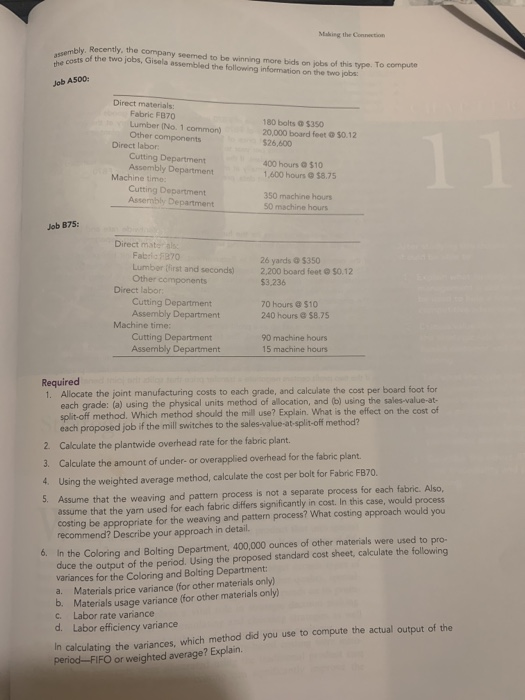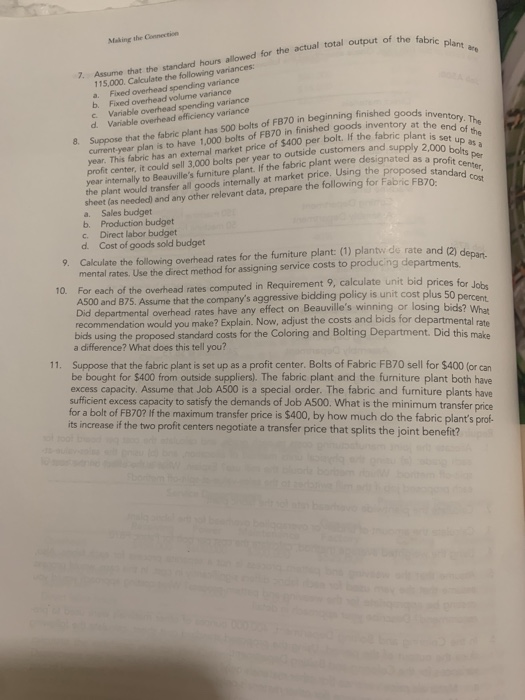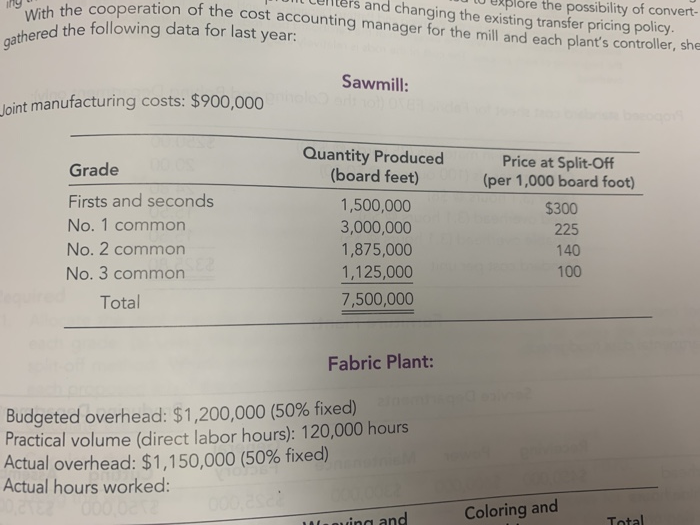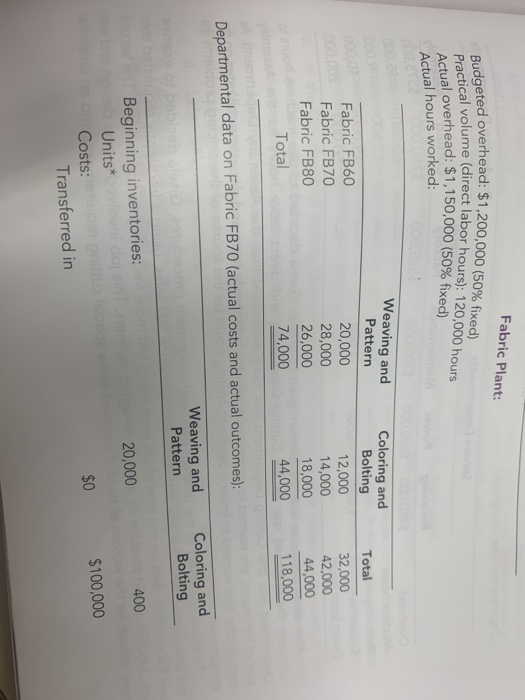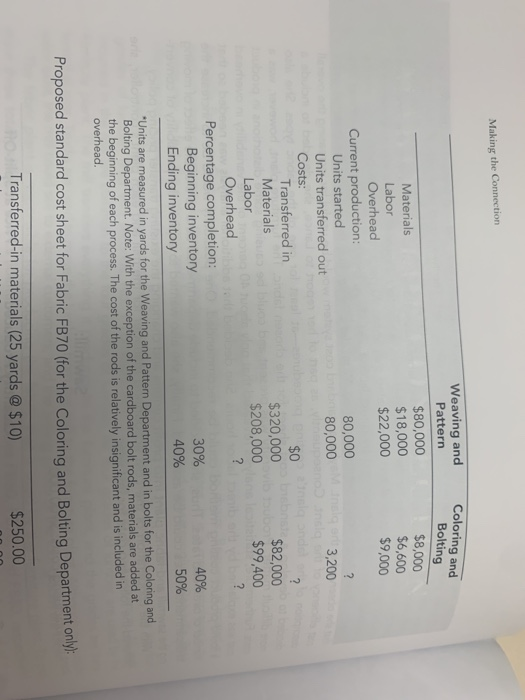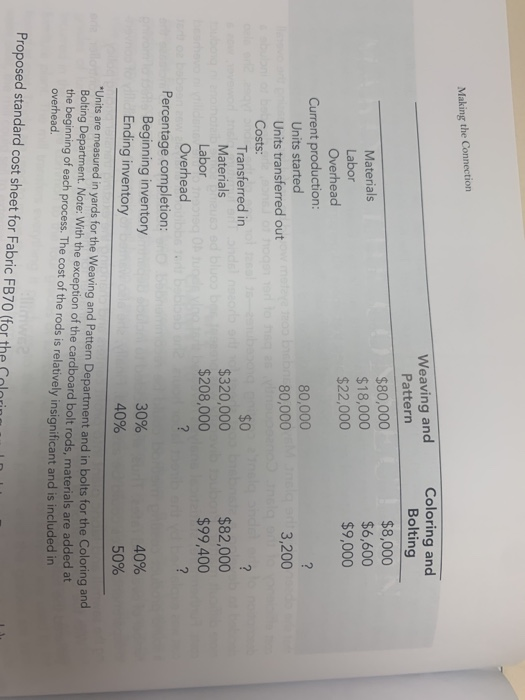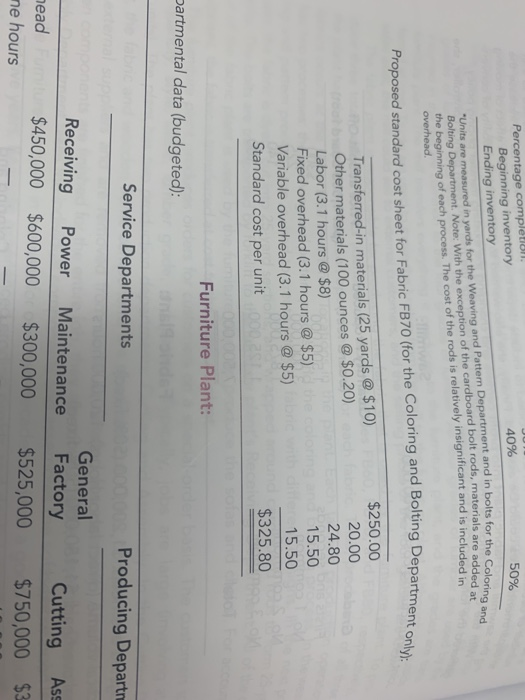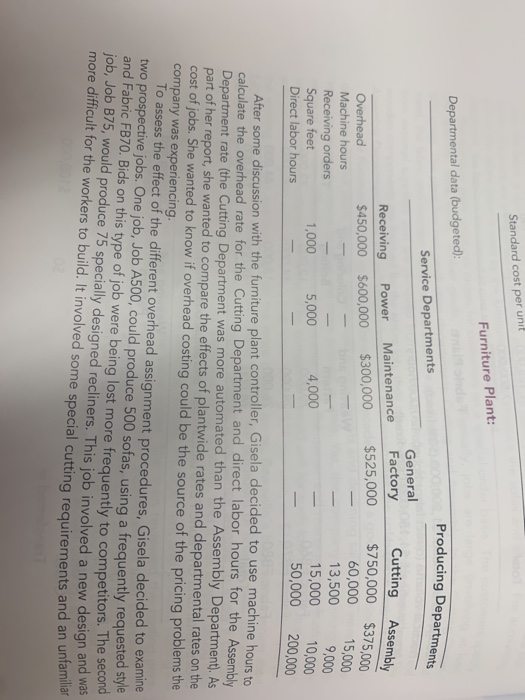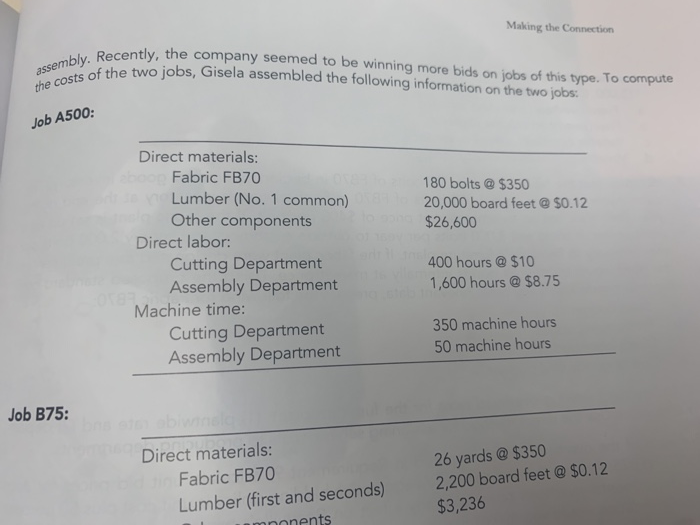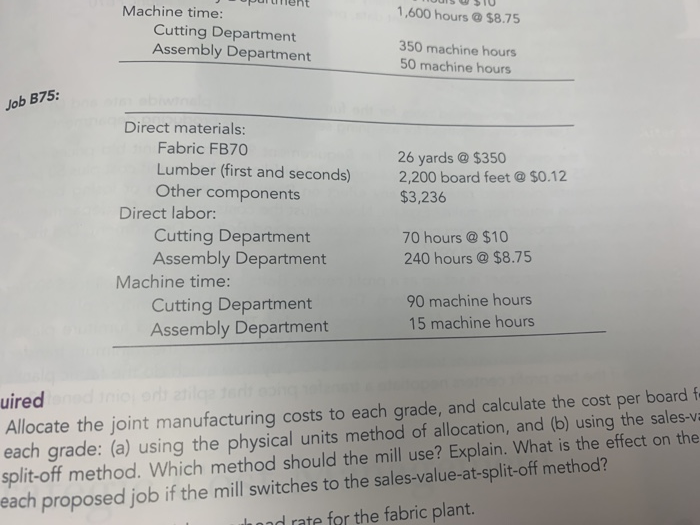MAKING THE CONN INTEGRATIVE EXERCISES Part 2 Chapters 5-10 medium-sized community in the southeastem part of the United States. It is a major employer in the community. In fact, the economic well-being of the community is tied very strongly to Beauville. Beau ville operates a sawmill, a fabric plant, and a furniture plant in the same community The sawmill buys logs from independent producers. The sawmill then procosses the logs into four grades of lumber: firsts and seconds, No. 1 common, No. 2 common, and No. 3 common. All cots incurred in the mill are common to the four grades of lumber. All four grades cumber are used by the fumiture plant. The mill transfers everything it produces to the fumiture plant,nd the grades are trans fered at cost. Trucks are used to move the lumber from the mill to the fumiture t Although sales exist, the mill could sell to extemal customers, and the selling prices of the fr grades are known. The fabric plant is responsible for producing the fabric that is used by the fumiture plant. To pro duce three totally different fabrics (identified by fabric ID codes FB60, FB70, and FB80, respectively, the plant has three separate production operations-one for each fabric. Thus, production of all three fabrics occurs at the same time in different locations in the plant. Each fabric's production operation has two processes: the weaving and pattern process and the coloring and bolting process. In the wea ing and pattem process, yam is used to create yards of fabric with different designs. In the next pro- cess, the fabric is dyed, cut into 25-yard sections, and wrapped around cardboard rods to form 25-yard bolts. The bolts are transported by forklift to the furniture plant's Receiving Department. All of the out put of the fabric plant is used by the furniture plant (to produce the sofas and chairs). For accounting purposes, the fabric is transferred at cost to the furniture plant. The furniture plant produces orders for customers on a special-order basis. The customers spechy the quantity, style, fabric, lumber grade, and pattern. Typically, jobs are large (involving at least 500 units). The plant has two production departments: Cutting and Assembly. In the Cutting Depan- ment, the fabric and wooden frame components are sized and cut. Other components are purchased from extemal suppliers and are removed from stores as needed for assembly. After the fabric and wooden components are finished for the entire job, they are moved to the Assembly Department. The Assembly Department takes the individual components and assembles the sofas (or chairs). Beauville Furniture has been in business for over two decades and has a good reputation. However, during the past five years, Beauville experienced eroding profits and declining sales. Bids were increas- ingly lost (even aggressive bids) on the more popular models. Yet, the company was winning bids on some of the more-difficult-to-produce items. Lance Hays, the owner and manager, was frustrated. he simply couldn't understand how some of his competitors could sell for such low prices. On a common sofa job involving 500 units, Beauville's bids were running $25 per unit, or $12,500 per job more than the winning bids (on average). Yet, on the more difficult items, Beauville's bids were running about $60 per unit less than the next closest bid. Gisela Berling, vice president of finance, was assigned the task of preparing a cost analysis of the company's product lines. Lance wanted to know if the con pany's costs were excessive. Perhaps the company was being wasteful, and it was simply costing more to produce furniture than it was costing its competitors Beauville Furniture Corporation produces sofas, recliners, and lounge chairs. Beauville is located in a no outside Gisela prepared herself by reading recent literature on cost management and product costing and attending several conferences that explored the same issues. She then reviewed the costing proce dures of the company's mill and two plants and did a preliminary assessment of their soundness. The production costs of the mill were common to all lumber grades and were assigned using the physical units method. Since the output and production costs were fairly uniform throughout the year, the mil used an actual costing system. Although Gisela had no difficulty with actual costing, she decided to 1 Fabric Plant: Budgeted overhead: $1,200,000 (50% fixed ) Practical volume (direct labor hours): 120,000 hours Actual overhead: $1,150,000 (50% fixed) Actual hours worked: 00.TEZ Weaving and Pattern Coloring and Bolting 00 000,0 Fabric FB60 Total 000,00 20,000 28,000 12,000 14,000 18,000 32,000 Fabric FB70 Fabric FB80 42,000 44,000 26,000 Total 74,000 44,000 118,000 A ins Departmental data on Fabric FB70 (actual costs and actual outcomes): meldoio Weaving and Pattern Coloring and Bolting Beginning inventories: Units* 20,000 400 Costs: Transferred in $0 $100,000 Making the Connection Weaving and Pattern $80,000 $18,000 $22,000 Coloring and Bolting $8,000 $6,600 $9,000 Materials Labor Overhead Current production: Units started Units transferred out 80,000 ? 80,000 g ort 3,200 Costs: $0 inala ande Transferred in Materials $320,000 $208,000 $82,000 $99,400 Labor Overhead ? Percentage completion: Beginning inventory Ending inventory 30% 40% 40% 50% "Units are measured in yards for the Weaving and Pattern Department and in bolts for the Coloring and Bolting Department. Note: With the exception of the cardboard bolt rods, materials are added at the beginning of each process. The cost of the rods is relatively insignificant and is included in overhead. Proposed standard cost sheet for Fabric FB70 (for the Coloring and Bolting Department only Transferred-in materials (25 yards@ $10) $250.00 Making the Connection Weaving and Pattern Coloring and Bolting Materials Labor Overhead $80,000 $18,000 $22,000 $ 8,000 $6,600 $9,000 Current production: Units started Units transferred out 80,000 ? 80,000 la 3,200 Costs: $0 $320,000 $208,000 Transferred in ? del neor bluoo b $82,000 $99,400 Materials Labor Overhead ? Percentage completion: Beginning inventory Ending inventory 30% 40% 40% 50% "Units are measured in yards for the Weaving and Pattern Department and in bolts for the Coloring and Bolting Department. Note: With the exception of the cardboard bolt rods, materials are added at the beginning of each process. The cost of the rods is relatively insignificant and is included in overhead. Proposed standard cost sheet for Fabric FB70 (for the Percentage complti8ln. Beginning inventory Ending inventory 40% 50% Units are measured in yards for the Weaving and Patten Department and in bolts for the Coloring and the beginning of each process. The cost of the rods is relatively insignificant and is included in overhead Bolting Department. Note: With the exception of the cardboard bolt rods, materials are added at 20M Proposed standard cost sheet for Fabric FB70 (for the Coloring and Bolting Department only): $250.00 Transferred-in materials (25 yards@$10) Other materials (100 ounces @ $0.20) Labor (3.1 hours @ $8) Fixed overhead (3.1 hours@ $5) Variable overhead (3.1 hours @ $5) Standard cost per unit 20.00 24.80 15.50 15.50 $325.80 Furniture Plant: partmental data (budgeted): Service Departments Producing Depart General Receiving Power Maintenance Factory Cutting Ass nead $450,000 $600,000 $300,000 ne hours $525,000 $750,000 $3 MAKING THE CONN INTEGRATIVE EXERCISES Part 2 Chapters 5-10 medium-sized community in the southeastem part of the United States. It is a major employer in the community. In fact, the economic well-being of the community is tied very strongly to Beauville. Beau ville operates a sawmill, a fabric plant, and a furniture plant in the same community The sawmill buys logs from independent producers. The sawmill then procosses the logs into four grades of lumber: firsts and seconds, No. 1 common, No. 2 common, and No. 3 common. All cots incurred in the mill are common to the four grades of lumber. All four grades cumber are used by the fumiture plant. The mill transfers everything it produces to the fumiture plant,nd the grades are trans fered at cost. Trucks are used to move the lumber from the mill to the fumiture t Although sales exist, the mill could sell to extemal customers, and the selling prices of the fr grades are known. The fabric plant is responsible for producing the fabric that is used by the fumiture plant. To pro duce three totally different fabrics (identified by fabric ID codes FB60, FB70, and FB80, respectively, the plant has three separate production operations-one for each fabric. Thus, production of all three fabrics occurs at the same time in different locations in the plant. Each fabric's production operation has two processes: the weaving and pattern process and the coloring and bolting process. In the wea ing and pattem process, yam is used to create yards of fabric with different designs. In the next pro- cess, the fabric is dyed, cut into 25-yard sections, and wrapped around cardboard rods to form 25-yard bolts. The bolts are transported by forklift to the furniture plant's Receiving Department. All of the out put of the fabric plant is used by the furniture plant (to produce the sofas and chairs). For accounting purposes, the fabric is transferred at cost to the furniture plant. The furniture plant produces orders for customers on a special-order basis. The customers spechy the quantity, style, fabric, lumber grade, and pattern. Typically, jobs are large (involving at least 500 units). The plant has two production departments: Cutting and Assembly. In the Cutting Depan- ment, the fabric and wooden frame components are sized and cut. Other components are purchased from extemal suppliers and are removed from stores as needed for assembly. After the fabric and wooden components are finished for the entire job, they are moved to the Assembly Department. The Assembly Department takes the individual components and assembles the sofas (or chairs). Beauville Furniture has been in business for over two decades and has a good reputation. However, during the past five years, Beauville experienced eroding profits and declining sales. Bids were increas- ingly lost (even aggressive bids) on the more popular models. Yet, the company was winning bids on some of the more-difficult-to-produce items. Lance Hays, the owner and manager, was frustrated. he simply couldn't understand how some of his competitors could sell for such low prices. On a common sofa job involving 500 units, Beauville's bids were running $25 per unit, or $12,500 per job more than the winning bids (on average). Yet, on the more difficult items, Beauville's bids were running about $60 per unit less than the next closest bid. Gisela Berling, vice president of finance, was assigned the task of preparing a cost analysis of the company's product lines. Lance wanted to know if the con pany's costs were excessive. Perhaps the company was being wasteful, and it was simply costing more to produce furniture than it was costing its competitors Beauville Furniture Corporation produces sofas, recliners, and lounge chairs. Beauville is located in a no outside Gisela prepared herself by reading recent literature on cost management and product costing and attending several conferences that explored the same issues. She then reviewed the costing proce dures of the company's mill and two plants and did a preliminary assessment of their soundness. The production costs of the mill were common to all lumber grades and were assigned using the physical units method. Since the output and production costs were fairly uniform throughout the year, the mil used an actual costing system. Although Gisela had no difficulty with actual costing, she decided to 1 Fabric Plant: Budgeted overhead: $1,200,000 (50% fixed ) Practical volume (direct labor hours): 120,000 hours Actual overhead: $1,150,000 (50% fixed) Actual hours worked: 00.TEZ Weaving and Pattern Coloring and Bolting 00 000,0 Fabric FB60 Total 000,00 20,000 28,000 12,000 14,000 18,000 32,000 Fabric FB70 Fabric FB80 42,000 44,000 26,000 Total 74,000 44,000 118,000 A ins Departmental data on Fabric FB70 (actual costs and actual outcomes): meldoio Weaving and Pattern Coloring and Bolting Beginning inventories: Units* 20,000 400 Costs: Transferred in $0 $100,000 Making the Connection Weaving and Pattern $80,000 $18,000 $22,000 Coloring and Bolting $8,000 $6,600 $9,000 Materials Labor Overhead Current production: Units started Units transferred out 80,000 ? 80,000 g ort 3,200 Costs: $0 inala ande Transferred in Materials $320,000 $208,000 $82,000 $99,400 Labor Overhead ? Percentage completion: Beginning inventory Ending inventory 30% 40% 40% 50% "Units are measured in yards for the Weaving and Pattern Department and in bolts for the Coloring and Bolting Department. Note: With the exception of the cardboard bolt rods, materials are added at the beginning of each process. The cost of the rods is relatively insignificant and is included in overhead. Proposed standard cost sheet for Fabric FB70 (for the Coloring and Bolting Department only Transferred-in materials (25 yards@ $10) $250.00 Making the Connection Weaving and Pattern Coloring and Bolting Materials Labor Overhead $80,000 $18,000 $22,000 $ 8,000 $6,600 $9,000 Current production: Units started Units transferred out 80,000 ? 80,000 la 3,200 Costs: $0 $320,000 $208,000 Transferred in ? del neor bluoo b $82,000 $99,400 Materials Labor Overhead ? Percentage completion: Beginning inventory Ending inventory 30% 40% 40% 50% "Units are measured in yards for the Weaving and Pattern Department and in bolts for the Coloring and Bolting Department. Note: With the exception of the cardboard bolt rods, materials are added at the beginning of each process. The cost of the rods is relatively insignificant and is included in overhead. Proposed standard cost sheet for Fabric FB70 (for the Percentage complti8ln. Beginning inventory Ending inventory 40% 50% Units are measured in yards for the Weaving and Patten Department and in bolts for the Coloring and the beginning of each process. The cost of the rods is relatively insignificant and is included in overhead Bolting Department. Note: With the exception of the cardboard bolt rods, materials are added at 20M Proposed standard cost sheet for Fabric FB70 (for the Coloring and Bolting Department only): $250.00 Transferred-in materials (25 yards@$10) Other materials (100 ounces @ $0.20) Labor (3.1 hours @ $8) Fixed overhead (3.1 hours@ $5) Variable overhead (3.1 hours @ $5) Standard cost per unit 20.00 24.80 15.50 15.50 $325.80 Furniture Plant: partmental data (budgeted): Service Departments Producing Depart General Receiving Power Maintenance Factory Cutting Ass nead $450,000 $600,000 $300,000 ne hours $525,000 $750,000 $3
